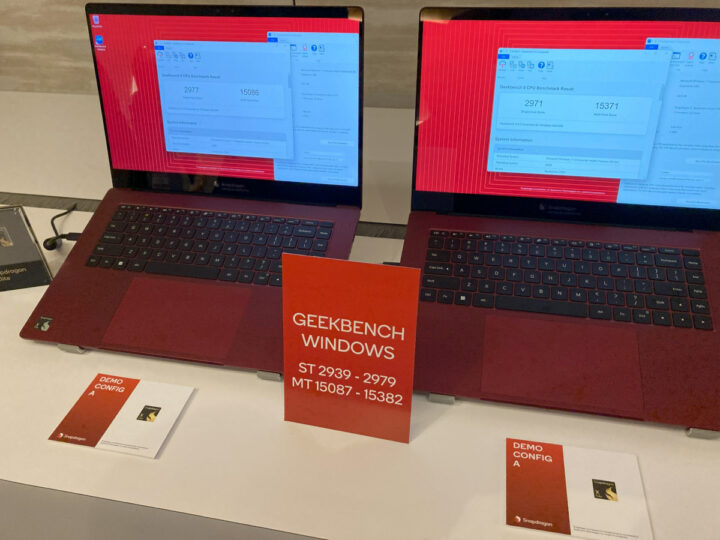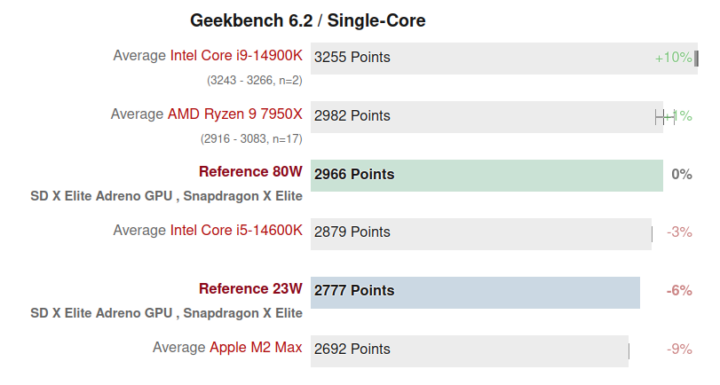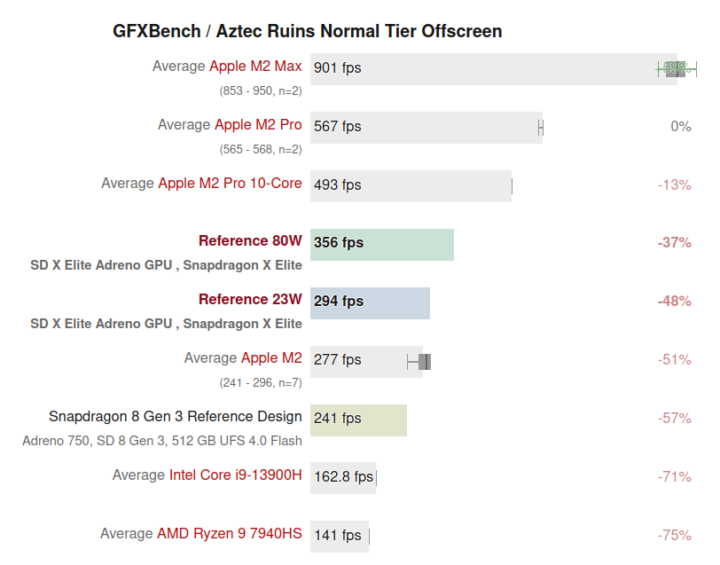Qualcomm unveiled the 4.3 GHz 12-core Snapdragon X Elite processor for laptops last week since some bold claims about the performance and efficiency. The company has now released benchmarks for the processor verified by third parties such as Anandtech and Notebookcheck showing the new Snapdragon processor performance is quite amazing with the Arm processor indeed matching Apple, Intel, and AMD high-end chips.
What’s more is that the new SoC was tested in both Windows and Linux (using Geekbench 6.2), so in hindsight, I was wrong to say the Snapdragon X Lite would be a Windows-only processor when only seeing the DX12 listed in the specifications…
Before we look into the benchmark results, we should note that Qualcomm provided two versions of the Snapdragon X Elite laptop prototype both using active cooling: “demo config A” high-performance system configured to run at an 80W TDP, and a low-power, thinner “demo config B” system set to 23W.
Demo Config A | Demo Config B |
|
|---|---|---|
| 2-core turbo (Max) | 4.3GHz | 4.0GHz |
| All core turbo (Max) | 3.8GHz | 3.4GHz |
| RAM | LPDDR5X-8533 |
|
| Display | 16.5-inch LCD (3840x2160) | 14.5-inch OLED (2880x1800) |
| Thickness | 16.8mm | 15mm |
| TDP | 80W | 23W |
| Battery | 87Wh | 58Wh |
Here are some of the results for both models in Windows 11.
| Demo Config A (80W) | Demo Config B (23W) | |
|---|---|---|
| Cinebench 2024 (single thread) | 132 | 124 |
| Cinebench 2024 (multi-thread) | 1227 | 997 |
| Geekbench 6.2 (single thread) | 2971 | 2780 |
| Geekbench 6.2 (multi-thread) | 15371 | 14029 |
| PCMark 10 | 13498 | 12737 |
| GFXBench Aztec Ruins - Normal | 354 fps | 294 fps |
| 3DMark Wildlife Extreme | 45 fps | 39 fps |
| UL Procyon AI | 1766 | 1813 |
The first remark is that I would have expected wider performance differences between the 23W and 80W systems, but the results are not that different. A chart on Notebookcheck shows the Snapdragon X Elite matches the Intel Core i5-14600K Comet Lake processor Geekbench 6.2 single-core benchmarks, where it also outperforms Apple M2 Max, comes close to the performance on AMD Ryzen 9 7950X, and the Intel Core i9-14900K is only 10 percent faster.
The Adreno GPU performance, as measured by GFXBench, is still far behind the graphics performance of the Apple M2 Max/Pro processors, but significantly better than the integrated GPUs found in Intel and AMD processors.
In Linux, we only have the scores for Geekbench 6.2 single-core and multi-core benchmarks for the 80W model.
- Geekbench 6.2 single-core – 3,236 points
- Geekbench 6.2 multi-core – 17,387 points
The results are higher in Linux partially because fan control is not working just yet in the open-source operating system, so the fan was active at full speed at all times.
As Anandtech notes, the selected benchmarks are mostly geared towards smartphones and tablets, rather than laptops and PCs, as Qualcomm wanted natively compiled benchmarks, or in other words no x86 emulation. to show the best performance of the system, and the company did not allow them to load their own benchmarks at this early stage of development. So we’ll likely need to wait until next year when the first commercially available Snapdragon X Elite laptops are expected to launch to get a wider range of benchmarks.
Thanks to TLS for the tip.

Jean-Luc started CNX Software in 2010 as a part-time endeavor, before quitting his job as a software engineering manager, and starting to write daily news, and reviews full time later in 2011.
Support CNX Software! Donate via cryptocurrencies, become a Patron on Patreon, or purchase goods on Amazon or Aliexpress







